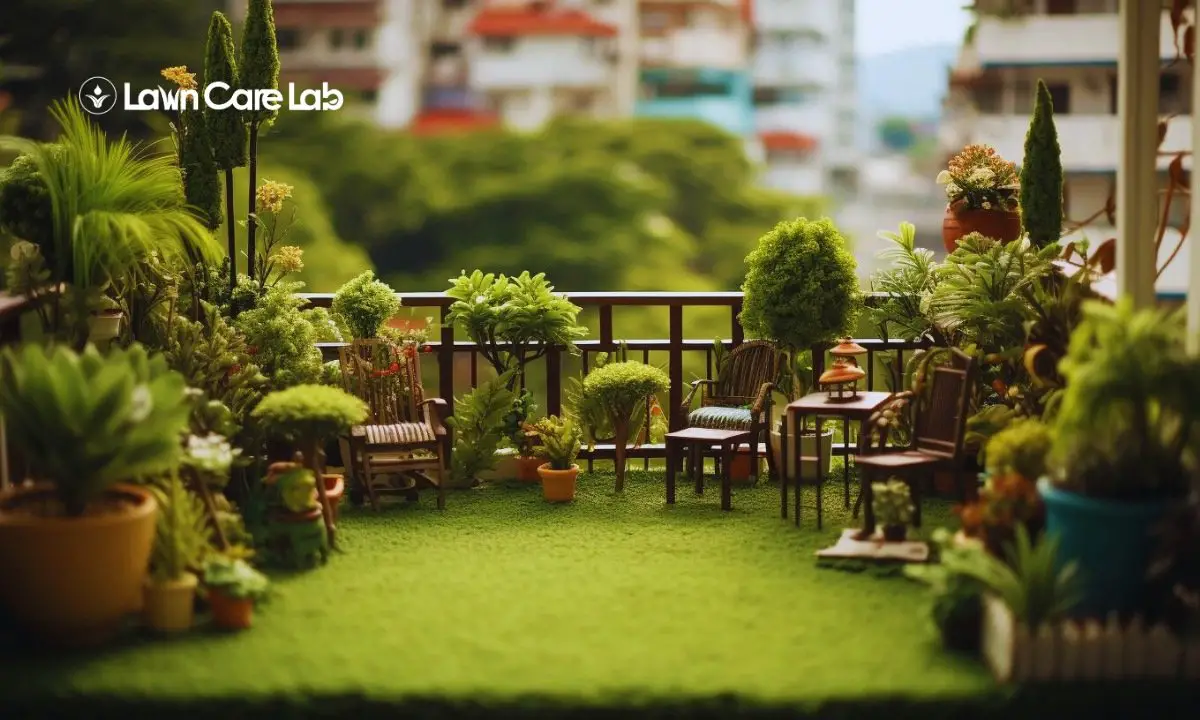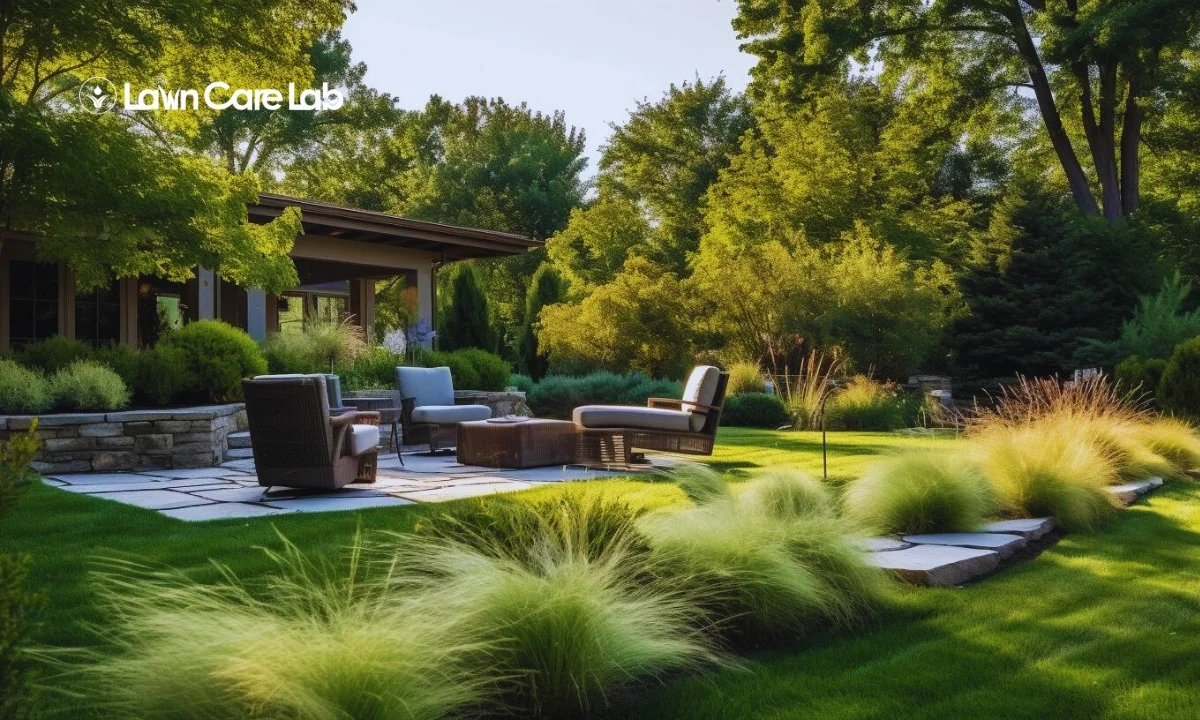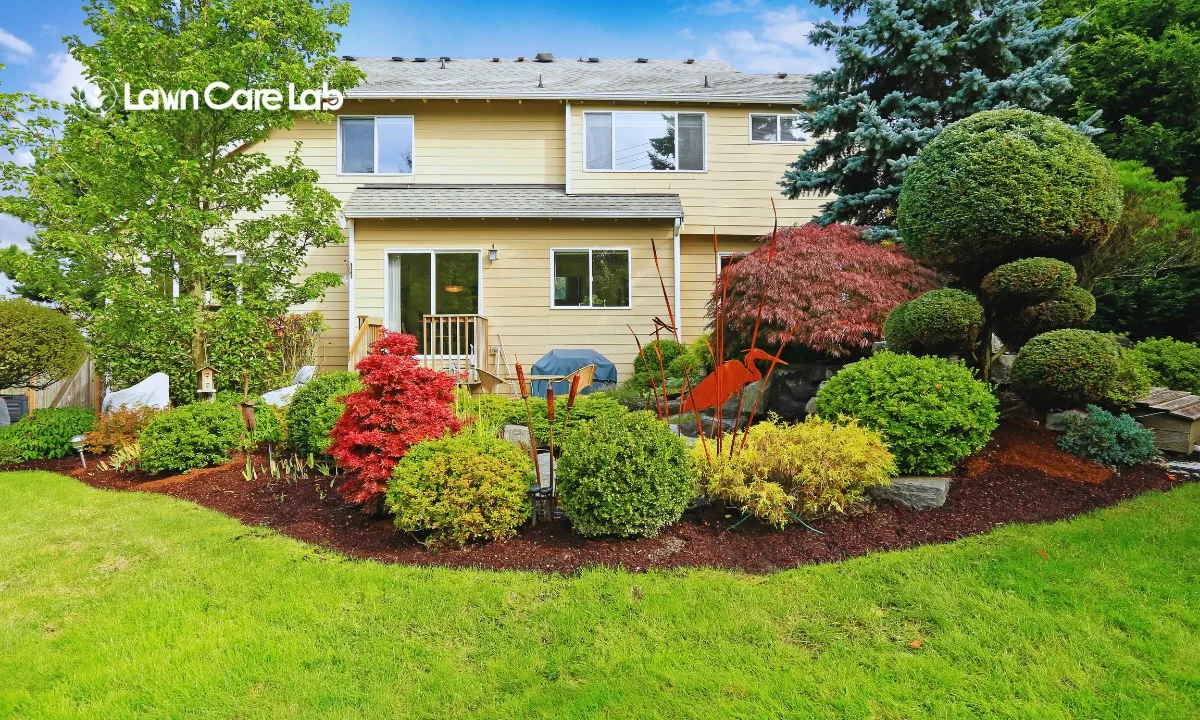Feeling hemmed in by the urban sprawl? Let not your spirit be dampened! With the advent of rooftop and balcony lawns, green spaces are quite literally reaching new heights.
Whether you’re well-versed in horticulture or just starting on your journey to greenery, this guide offers practical advice to create and maintain a private aerial oasis on your roof or balcony. With a little guidance, transforming your outdoor space into a serene sanctuary is easier than you think!
Bringing the green to your scene doesn’t mean a trip to the countryside. Often, it’s just a matter of looking up.
Table of Contents
The Concept of Rooftop and Balcony Lawns
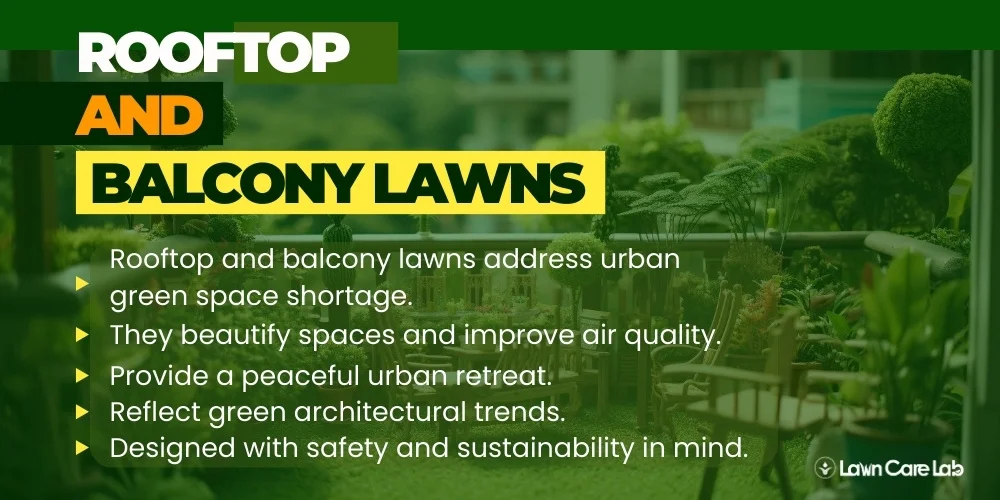
You may be curious about the significance of rooftop and balcony lawns. These verdant spaces aren’t just a fleeting trend but a smart response to the pressing issue of shrinking urban green spaces.
Consider the possibility of turning an idle roof or balcony into a vibrant, green lawn. This transformation adds visual charm and contributes to an eco-conscious lifestyle by purifying the surrounding air.
Amid the daily urban chaos, your personal rooftop lawn provides a peaceful sanctuary, a quiet respite. These inventive green spaces are a reflection of architectural progress and the growing role of urban greening in contemporary times.
As for safety concerns, you can be confident that these lawns are meticulously designed with an emphasis on security and sustainability.
The Benefits of Sky-High Green Spaces
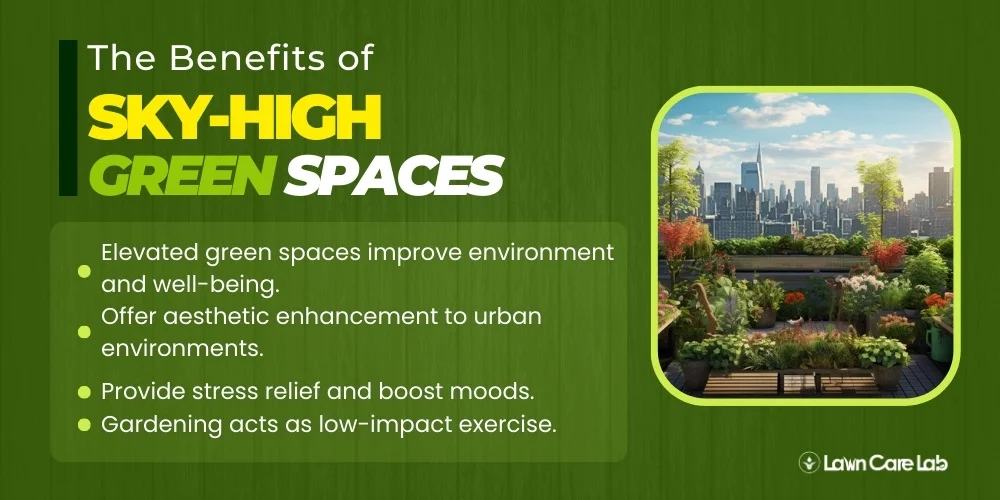
Embracing rooftops and balconies as verdant sanctuaries offer a multitude of benefits that stretch far beyond their visual charm. These sky-high green scapes do wonders for both the environment and our well-being.
Environmental Impact
Sky gardens benefit urban areas by providing natural habitats, reducing pollution, lowering noise levels, and mitigating the urban heat island effect.
Here’s how these elevated gardens contribute:
- Air Quality Improvement: The greenery absorbs pollutants and releases oxygen, acting as a natural air purifier.
- Noise Reduction: Plants serve as an organic sound barrier, promoting a quieter, more peaceful atmosphere.
- Urban Wildlife Habitat: These spaces offer shelter to birds and insects, fostering biodiversity in cities.
Green spaces counter the urban heat island effect, reduce energy consumption for cooling, and increase sustainability.
Aesthetic Appeal
Transforming a rooftop into a blossoming landscape offers an aesthetic oasis that elevates the urban skyline. With thoughtful plant selection, these green retreats can remain lush year-round, offering a continuous spectacle of natural beauty and providing a serene escape from the urban frenzy.
Green spaces add to the beauty of your home and contribute positively to the environment by providing a safe haven for wildlife.
Health Benefits
The benefits of a rooftop or balcony garden extend beyond aesthetics and include wellness advantages.
- Psychological Health: Green spaces provide a serene respite from urban clamor, alleviating stress and brightening your mood.
- Physical Fitness: Gardening is a delightful, low-impact exercise. It’s an excellent way to maintain fitness without even recognizing it as a workout.
- Community Value: These areas can function as community spaces, promoting social engagement and nurturing a communal spirit.
Therefore, in a time when health and safety are of utmost concern, your elevated garden transcends being a mere architectural feature. It transforms into your private health and wellness refuge, conveniently located right outside your door.
Preparing Your Rooftop or Balcony for a Lawn
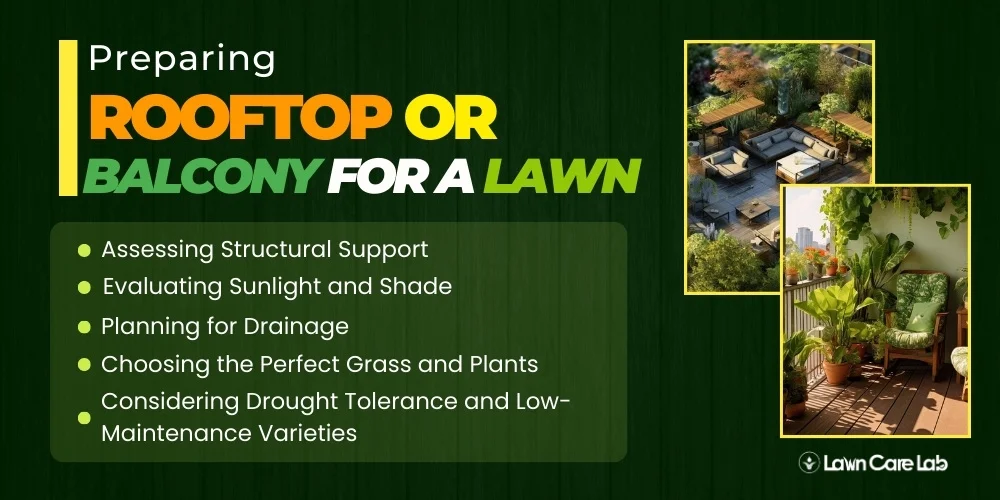
When creating a rooftop or balcony garden, remember to assess the building’s structural strength, consider sun exposure for plant selection, and implement an efficient drainage system.
Assessing Structural Support
Before cultivating your verdant vision atop your abode, the pivotal first step is a rigorous assessment of the structural integrity of your space. Overlooking this could lead to undue strain on your building, affecting its stability and longevity.
Here’s a rundown of steps to take into account:
- Consult the Experts: Engage with a qualified structural engineer to evaluate the load-bearing capacity of your building. These professionals possess the acumen to identify structural challenges and prioritize the safety and feasibility of your rooftop or balcony garden dreams.
- Navigating Regulations: Diligently acquaint yourself with local building codes and ordinances. Adhering to these regulations ensures that your garden meets legal standards and maintains structural integrity.
- Water Management: Water may seem a minor addition, but in the context of your garden, it’s a weighty consideration. An effective drainage plan is essential, curtailing the risk of water buildup and, in turn, reducing the stress on the building’s structure.
Safety should invariably be your primary concern when envisaging your elevated lush space.
Evaluating Sunlight and Shade
Building stability is non-negotiable, but another pivotal factor to consider when preparing your rooftop or balcony for a verdant lawn is the sunlight and shade it receives.
Spend time observing your area throughout the day, keenly noting the periods of sunlight and shade. The sun-shade dynamics of your space are key to comprehend, as different plants have distinct sunlight needs.
For instance, full-sun plants flourish with six or more hours of direct sunlight daily, while those favoring shade thrive with less. It’s worth highlighting that rooftops often have higher exposure to sunlight and higher temperatures than ground-level gardens.
Conversely, balconies may have more shade due to surrounding structures. With thoughtful observation and strategic planning, you can cultivate a lush, green rooftop or balcony lawn tailored to your unique space.
Planning for Drainage
Proper drainage planning is often a crucial step when getting ready to transform your rooftop or balcony into a lush landscape. This step isn’t to be overlooked as it helps to avoid complications such as waterlogging and potential damage to the structure of your building.
Here’s a straightforward guide to aid your drainage planning:
- Spot the lowest point on your surface. This will be the place where water tends to gather.
- Fit drainage outlets at this point.
- Make sure these outlets are linked to your building’s existing drainage system.
- Design a subtle slope leading towards these outlets.
- This design will assist in guiding the water flow towards the outlets.
- Opt for materials that can retain water for your lawn.
- These materials should retain sufficient moisture to facilitate plant growth while simultaneously allowing excessive water to drain off.
A well-executed drainage system ensures that your elevated green space lasts longer and also protects the integrity of your building’s structure.
Choosing the Perfect Grass and Plants
Choosing the right greenery for your elevated garden is not just about looks, but also practicality. Consider the maintenance requirements and resilience to drought conditions. Opt for low maintenance and resilient greenery to ensure your garden thrives without imposing a heavy upkeep demand.
Groundcover vs. Turfgrass
While the charm of classic turfgrass may entice you to your rooftop or balcony garden, the practicality and benefits of low-maintenance groundcover plants warrant serious consideration.
Groundcover plants:
- Less care, more time: Groundcover plants demand less attention than turfgrass, freeing you up to enjoy your garden rather than toil in it. They thrive with less watering and mowing, significantly reducing your workload.
- Survival in arid conditions: These plants have evolved to withstand dry conditions, making them an excellent choice for sun-drenched rooftops.
- Weed combatants: Their thick, lush growth acts as a natural weed barrier, cutting down on the need for potentially harmful weed killers.
On the other hand, turfgrass offers a timeless lawn aesthetic but comes with an increased need for maintenance. Thus, it’s essential to evaluate both options thoroughly. Prioritizing safety in elevated gardens leads us to the next topic of conversation—choosing low-maintenance varieties.
Considering Drought Tolerance and Low-Maintenance Varieties
When choosing plants for an urban balcony lawn that are both drought-tolerant and require low maintenance, here is a list of suitable options that can withstand periods of dry conditions and won’t demand too much of your time:
- Sedum (Stonecrop): Offers a variety of species known for their succulent foliage and resilience in dry conditions.
- Festuca (Blue Fescue): A small, ornamental grass that provides a blue-grey hue and thrives in less fertile soil.
- Echeveria: A popular succulent with rosette shapes that enjoys full sun and infrequent watering.
- Senecio (Dusty Miller): Valued for its silver-grey foliage and tolerance to drought.
- Lavandula (Lavender): Aromatic and drought-resistant, it’s also a pollinator-friendly option.
- Portulaca (Moss Rose): A sun-loving, drought-tolerant groundcover with colorful, rose-like flowers.
- Thymus (Creeping Thyme): An evergreen herb that forms a dense mat and requires minimal water once established.
- Rosmarinus (Rosemary): A hardy herb that enjoys the heat, is flavorful for cooking and requires little watering.
- Agave: A striking, architectural plant that can tolerate drought and high heat.
- Yucca: Typically has tough, sword-shaped leaves and is highly adaptable to drought conditions.
Choose drought-resistant plants with extensive root systems or waxy/hairy leaves for a strong rooftop garden that can withstand dry conditions caused by sunlight and wind exposure.
Successful Installation of Rooftop and Balcony Lawns
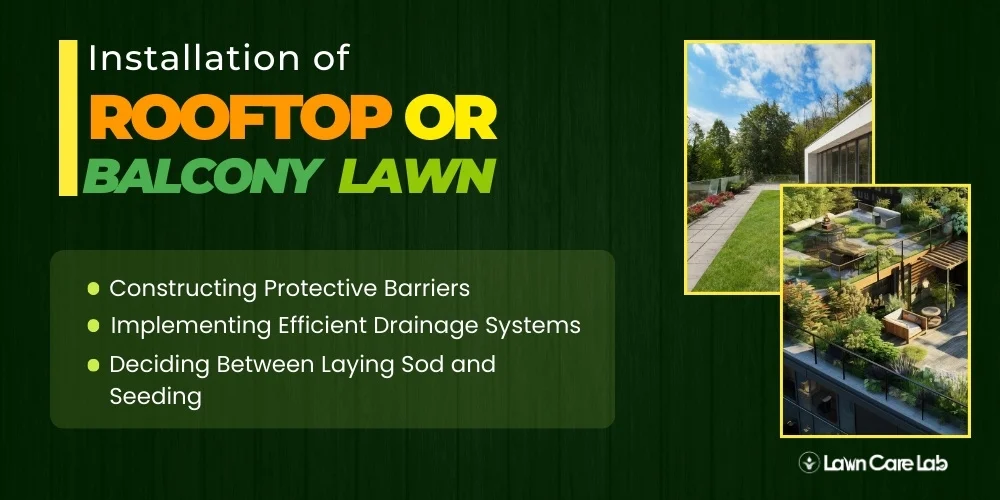
Protective barriers and proper drainage are crucial for setting up a green sanctuary in the sky. The final step involves choosing between laying sod or sowing seeds. Each step is essential in creating a healthy, sustainable ecosystem that thrives in an elevated setting. Let’s bring greenery to us and contribute to the betterment of our environment.
Constructing Protective Barriers
Before setting up your rooftop or balcony garden, comprehending the significance of building defensive structures is key. These protective measures serve as the first shield, protecting the framework of your building from any potential harm.
Here are some vital aspects to consider when building these defensive structures:
- Use high-density polyethylene, PVC, or a waterproof membrane. Opt for weather-resistant materials like wood, metal, or plastic, each with aesthetics, maintenance, and durability trade-offs.
- Aim for a blend of functionality and visual appeal to enhance your garden’s look.
- Seek expert advice for accurate installation.
- Ensure the barriers provide safety and maintain building integrity.
Your security and the lifespan of your green space hinge on these important steps.
Implementing Efficient Drainage Systems
Selecting loose and well-aerated soil is crucial for a drainage strategy that facilitates proper water movement. Investing time in establishing a robust drainage foundation is essential. An effective drainage system is key to the vitality of an elevated lawn, ensuring it flourishes as a peaceful retreat.
Here’s a simple guide on how to do it.
Begin with a geotextile fabric layer to separate the soil from the drainage materials, preventing them from mixing.
Add a layer of lightweight aggregate, like expanded clay or gravel, which holds water for plant use and allows air circulation, promoting healthy roots.
For the next step, Install perforated pipes within the drainage layer which will channel excess water away, safeguarding your plants and the integrity of the building.
Lastly, Include an overflow outlet at your lawn’s highest point to prevent water accumulation, eliminating potential damage to your green space and the structure beneath it.
Deciding Between Laying Sod and Seeding
Crafting the perfect rooftop or balcony green space involves making a critical decision: Should you lay sod or opt for seeding? This decision will depend on your budgetary constraints, your visual inclinations, and how much time you’re willing to invest. Let’s break down these considerations:
- Budget: Sod is more expensive but instant; seeding is budget-friendly but requires patience.
- Aesthetic: Sod translates to immediate greenery; seeds take time to fill in.
- Time: Choose sod for quick results or seed if you prefer a gradual, natural growth process.
- Structural capacity: Confirm your rooftop or balcony can bear the weight of sod or seed soil.
A crucial factor to bear in mind is the structural capacity of your rooftop or balcony. It’s vital to verify that it can bear the weight of your lawn, be it sod or seed. As with any decision, it’s up to you to weigh these factors and make a choice that best aligns with your aspirations and financial capabilities.
Maintenance Tips for Your Elevated Lawn
To keep your lawn healthy, consistently water it and choose suitable fertilizers. Master the art of mowing and trimming for your specific outdoor space. Never cut more than a third of the grass height at once. Remember, your lawn is a living ecosystem that needs your care to thrive.
Effective Watering Techniques
To keep your rooftop or balcony lawn healthy, water it deeply instead of frequently. This helps roots grow deeper, making your lawn more resistant to drought.
- Employ a soil probe to gauge the depth of moisture. Dry soil beyond the initial 2-3 inches signals the need for watering.
- Aim to water in the early morning hours. This minimizes evaporation and curbs the spread of diseases.
- Beware of overwatering. Excess water can stunt root growth and foster an environment ripe for disease.
- Implement a robust drainage system to avert water pooling.
- A moisture meter can be a valuable tool to prevent overwatering.
Follow these guidelines for a healthy rooftop or balcony green space, but remember that proper hydration is not the only requirement for lawn health.
Now, let’s transition to discussing the importance of balanced fertilization to supplement your watering routine.
Appropriate Fertilization
Apply appropriate fertilizers matching your grass type cautiously, adhering to recommended rates and schedules.
The following reference chart should assist:
| Grass Type | Soil Condition | Suggested Fertilizer |
|---|---|---|
| Bermuda | Acidic | Slow-release Nitrogen |
| St. Augustine | Alkaline | Slow-release Potassium |
| Zoysia | Neutral | Balanced N-P-K |
| Suggested Frequency | Recommended Rate |
|---|---|
| Every 6-8 weeks | 1 pound per 1000 sq. ft. |
Over-fertilization can harm your lawn, so follow these guidelines for a lush, vibrant lawn. Prioritize safety in all your lawn care practices.
Considerations for Mowing and Trimming
After deciding on the ideal fertilizer for your rooftop lawn, you should focus on the vital tasks of mowing and trimming. These undertakings are key for a verdant and orderly lawn, but they warrant thoughtful planning.
Here are some tips for maintaining your lofty lawn with an emphasis on safety:
- Avoid trimming more than a third of the grass blade at a time. This tactic reduces stress on the plants and lessens their vulnerability to pests and diseases.
- Always ensure your blade is sharp for clean cuts to minimize harm to the grass.
- Keep a vigilant eye on your mower’s blade, honing it as required.
- Adhere to a regular mowing timetable. This encourages uniform growth and contributes to the overall well-being of your lawn.
- Refrain from mowing during the peak heat of the day to protect your grass from heat stress.
Addressing Common Challenges with Rooftop
Maintaining a rooftop lawn requires preventing wind damage, controlling weed and pest growth, and regulating soil temperature.
- Combat Wind Damage: Install windbreakers, plant wind-resistant varieties to shelter your garden from strong winds, and regularly water to counteract moisture loss.
- Control Weeds and Pests: Conduct frequent inspections for early detection of weeds and pests; use targeted treatments and consider weed suppressant fabrics for prevention.
- Regulate Soil Temperature: Protect roots from heat with light-colored mulch and choose heat-tolerant grass species to ensure a thriving rooftop lawn.
This principle also rings true in gardening, where simple, mindful practices can help you overcome complex challenges. And remember, the beauty and serenity of a well-maintained rooftop lawn are worth the effort.
Making the Most of Your Rooftop Green Space
Your rooftop garden can be a vibrant sanctuary adorned with fragrant herbs and vivid flowers, offering both a feast for the senses and a haven for pollinators. This lofty green space elevates the ambiance of social gatherings and offers you a serene escape in the convenience of your home.
Select resilient flowers and herbs that can withstand the unique rooftop climate, like hearty Marigolds and aromatic Rosemary, to ensure your garden thrives. As your green retreat flourishes, it becomes an idyllic backdrop for memorable events and peaceful personal respite alike, enhancing mental well-being and outdoor enjoyment.
Remember, safety is crucial—keep your garden accessible and secure, letting this elevated slice of nature enrich your urban living experience to the fullest.
- How Green Spaces Influence Community Interactions - July 8, 2024
- Lawn Fungal Diseases: Identification and Treatment - July 3, 2024
- Lawn Care for All Seasons: A Year-Round Guide for Extreme Climates - June 24, 2024

